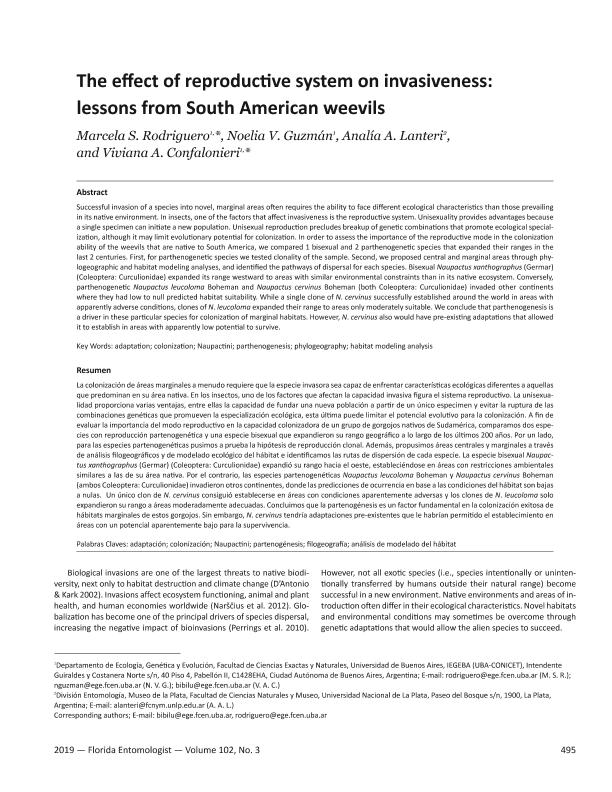Mostrar el registro sencillo del ítem
dc.contributor.author
Rodriguero, Marcela Silvina

dc.contributor.author
Guzman, Noelia Veronica

dc.contributor.author
Lanteri, Analia Alicia

dc.contributor.author
Confalonieri, Viviana Andrea

dc.date.available
2022-02-04T20:07:31Z
dc.date.issued
2019-09
dc.identifier.citation
Rodriguero, Marcela Silvina; Guzman, Noelia Veronica; Lanteri, Analia Alicia; Confalonieri, Viviana Andrea; The Effect of Reproductive System on Invasiveness: Lessons from South American Weevils; Florida Entomological Society; Florida Entomologist; 102; 3; 9-2019; 495-500
dc.identifier.issn
0015-4040
dc.identifier.uri
http://hdl.handle.net/11336/151409
dc.description.abstract
Successful invasion of a species into novel, marginal areas often requires the ability to face different ecological characteristics than those prevailing in its native environment. In insects, one of the factors that affect invasiveness is the reproductive system. Unisexuality provides advantages because a single specimen can initiate a new population. Unisexual reproduction precludes breakup of genetic combinations that promote ecological specialization, although it may limit evolutionary potential for colonization. In order to assess the importance of the reproductive mode in the colonization ability of the weevils that are native to South America, we compared 1 bisexual and 2 parthenogenetic species that expanded their ranges in the last 2 centuries. First, for parthenogenetic species we tested clonality of the sample. Second, we proposed central and marginal areas through phylogeographic and habitat modeling analyses, and identified the pathways of dispersal for each species. Bisexual Naupactus xanthographus (Germar) (Coleoptera: Curculionidae) expanded its range westward to areas with similar environmental constraints than in its native ecosystem. Conversely, parthenogenetic Naupactus leucoloma Boheman and Naupactus cervinus Boheman (both Coleoptera: Curculionidae) invaded other continents where they had low to null predicted habitat suitability. While a single clone of N. cervinus successfully established around the world in areas with apparently adverse conditions, clones of N. leucoloma expanded their range to areas only moderately suitable. We conclude that parthenogenesis is a driver in these particular species for colonization of marginal habitats. However, N. cervinus also would have pre-existing adaptations that allowed it to establish in areas with apparently low potential to survive.
dc.format
application/pdf
dc.language.iso
eng
dc.publisher
Florida Entomological Society

dc.rights
info:eu-repo/semantics/openAccess
dc.rights.uri
https://creativecommons.org/licenses/by-nc-sa/2.5/ar/
dc.subject
ADAPTATION
dc.subject
COLONIZATION
dc.subject
HABITAT MODELING ANALYSIS
dc.subject
NAUPACTINI
dc.subject
PARTHENOGENESIS
dc.subject
PHYLOGEOGRAPHY
dc.subject.classification
Biología

dc.subject.classification
Ciencias Biológicas

dc.subject.classification
CIENCIAS NATURALES Y EXACTAS

dc.title
The Effect of Reproductive System on Invasiveness: Lessons from South American Weevils
dc.type
info:eu-repo/semantics/article
dc.type
info:ar-repo/semantics/artículo
dc.type
info:eu-repo/semantics/publishedVersion
dc.date.updated
2020-11-20T14:43:43Z
dc.journal.volume
102
dc.journal.number
3
dc.journal.pagination
495-500
dc.journal.pais
Estados Unidos

dc.journal.ciudad
Nueva York
dc.description.fil
Fil: Rodriguero, Marcela Silvina. Consejo Nacional de Investigaciones Científicas y Técnicas. Oficina de Coordinación Administrativa Ciudad Universitaria. Instituto de Ecología, Genética y Evolución de Buenos Aires. Universidad de Buenos Aires. Facultad de Ciencias Exactas y Naturales. Instituto de Ecología, Genética y Evolución de Buenos Aires; Argentina
dc.description.fil
Fil: Guzman, Noelia Veronica. Consejo Nacional de Investigaciones Científicas y Técnicas. Oficina de Coordinación Administrativa Ciudad Universitaria. Instituto de Ecología, Genética y Evolución de Buenos Aires. Universidad de Buenos Aires. Facultad de Ciencias Exactas y Naturales. Instituto de Ecología, Genética y Evolución de Buenos Aires; Argentina
dc.description.fil
Fil: Lanteri, Analia Alicia. Universidad Nacional de La Plata. Facultad de Ciencias Naturales y Museo; Argentina. Consejo Nacional de Investigaciones Científicas y Técnicas. Centro Científico Tecnológico Conicet - La Plata; Argentina
dc.description.fil
Fil: Confalonieri, Viviana Andrea. Universidad de Buenos Aires. Facultad de Ciencias Exactas y Naturales. Departamento de Ecología, Genética y Evolución. Grupo de Investigación en Filogeografía y Filogenias Moleculares; Argentina
dc.journal.title
Florida Entomologist

dc.relation.alternativeid
info:eu-repo/semantics/altIdentifier/url/https://bioone.org/journals/florida-entomologist/volume-102/issue-3/024.102.0309/The-Effect-of-Reproductive-System-on-Invasiveness--Lessons-from/10.1653/024.102.0309.full
dc.relation.alternativeid
info:eu-repo/semantics/altIdentifier/doi/http://dx.doi.org/10.1653/024.102.0309
Archivos asociados
